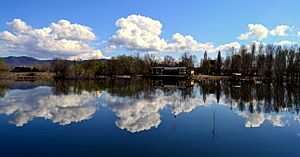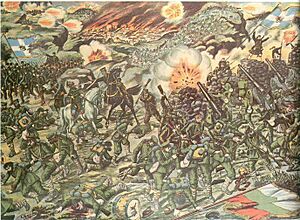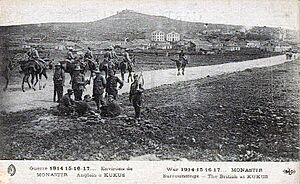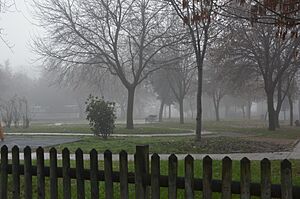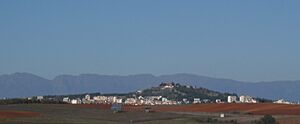Kilkis facts for kids
Quick facts for kids
Kilkis
Κιλκίς
|
|
|---|---|
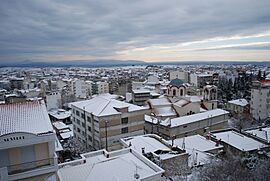
The town in winter
|
|
| Country | Greece |
| Administrative region | Central Macedonia |
| Regional unit | Kilkis |
| Area | |
| • Municipality | 1,599.6 km2 (617.6 sq mi) |
| • Municipal unit | 319.8 km2 (123.5 sq mi) |
| Elevation | 280 m (920 ft) |
| Population
(2021)
|
|
| • Municipality | 45,308 |
| • Municipality density | 28.3246/km2 (73.3603/sq mi) |
| • Municipal unit | 27,493 |
| • Municipal unit density | 85.969/km2 (222.66/sq mi) |
| Community | |
| • Population | 24,130 (2021) |
| Time zone | UTC+2 (EET) |
| • Summer (DST) | UTC+3 (EEST) |
| Postal code |
611 00
|
| Area code(s) | 23410 |
| Vehicle registration | NI, ΚΙ* |
| Website | www.e-kilkis.gr |
Kilkis (Greek: Κιλκίς) is a city in Central Macedonia, Greece. It's the main city of the Kilkis area. In 2021, about 24,130 people lived in the city itself. If you count the wider municipal unit, there were 27,493 people, and the whole municipality had 45,308 residents.
Kilkis has seen a lot of history, especially during the 20th century. It was a battleground many times. This included the Macedonian Struggle, the Balkan Wars, World War I, World War II, and the Greek civil war.
Contents
What's in a Name? The Story of Kilkis
Kilkis is in a part of the world that has been home to many different groups of people. Because of this, the city has been known by several names throughout history.
In ancient Roman and early Byzantine times, it was called Callicum or Callicus. This Greek name (Καλλικών, Καλλικώς) might have meant "beautiful place." Later, it became known as Kalkis or Kilkis.
In Bulgarian and Macedonian languages, the city is called Kukush (Кукуш). An old Greek church record from 1732 mentions it as Kilkisi (Κηλκήση). A Slavic church record from 1741 calls it Kukush. The Ottomans, who ruled the area for a long time, called it Kılkış.
How Kilkis is Organized
The Municipality of Kilkis
The municipality of Kilkis is like a larger local government area. It was created in 2011 by joining seven smaller areas, which are now called municipal units. These units include:
- Cherso
- Doirani
- Gallikos
- Kilkis (the city itself)
- Kroussa
- Mouries
- Pikrolimni
The total area of the municipality is about 1,599.6 square kilometers. The municipal unit of Kilkis, which includes the city and nearby villages, covers about 319.8 square kilometers.
Local Communities
The municipal unit of Kilkis is made up of several smaller communities, which are like neighborhoods or groups of villages. The main community is Kilkis itself, which includes the city and nearby places like Argyroupoli and Metalliko. Other communities are Chorygi, Efkarpia, and Kristoni, among others.
A Journey Through Time: History of Kilkis
Ancient Times
People have lived in the Kilkis area for a very long time. Scientists have found old tombs and items from the Bronze and Iron Ages, dating back thousands of years.
During classical antiquity, the powerful kingdom of Macedon ruled this region. Kilkis was in the middle of an area called Krestonia. Legend says that when Philip II of Macedon, the father of Alexander the Great, visited Krestonia, he loved the local olives! Many towns thrived here back then, like Idomeni, Atalanti, and Evropos.
Roman and Byzantine Eras
Around 148 BC, the Romans took control of the area. Later, during late antiquity, different tribes like the Goths, Huns, and Slavs invaded. Some of these groups settled in the Balkan Peninsula.
In the Middle Ages, Kilkis was often caught between the Byzantine and Bulgarian Empires. It changed hands many times. In the 10th century, Bulgarians attacked the city. Some people from Kilkis even moved to southern Italy and founded a village there.
Under Ottoman Rule
The good times ended in 1430 when the Ottoman Empire took over Macedonia, including Kilkis. For a long time, Kilkis was known as a village called Kukush.
By the mid-19th century, Kilkis was a town with a mix of people. Most were Bulgarians, but there were also Greeks and Turks. In the late 1800s and early 1900s, Kilkis was part of the Ottoman Empire's Salonica region.
Many local Bulgarians were involved in the Internal Macedonian Revolutionary Organization (IMRO), a group fighting for freedom. Gotse Delchev, a famous leader of IMRO, was born in Kilkis (then called Kukush). Greeks also fought for their rights in the area, with some local families supporting their efforts.
Balkan Wars and World War I
In 1912, during the First Balkan War, the Ottoman Empire lost most of its European lands. Kilkis became part of Bulgaria. But in 1913, during the Second Balkan War, the Greek army fought a big battle called the Battle of Kilkis-Lahanas. It lasted three days and was very tough for both sides. Greece even named a battleship, the Kilkís, after this important victory.
After the battle, Kilkis was badly damaged and almost completely destroyed. Most of its Bulgarian residents moved to Bulgaria. The new town was rebuilt closer to the railway line. Many Greeks who had been forced to leave the Ottoman Empire and Bulgaria settled here. So many came from the Strumica area that Kilkis was even temporarily called Néa Stromnítsa (New Strumica).
During World War I, Kilkis was again in a war zone, as part of the Macedonian front.
In the 1920s, after more conflicts, many more Greek refugees came to Kilkis. These new residents helped the region grow. Many of them were Caucasus Greeks from areas that are now part of Turkey. They moved to Kilkis and other parts of Greece between 1919 and 1921.
World War II and After
During World War II, Germany occupied Kilkis. Later, it became part of the Bulgarian zone. A major event during this time was the Battle of Kilkis (1944) in November 1944.
After the wars, Kilkis grew. In the 1970s and 80s, many new apartment buildings were constructed. A ring road was also built around the town in the 1980s to help with traffic.
Culture
Kilkis is home to the Techni Art Association, which promotes art and culture in the city.
Economy
Kilkis is an industrial town. One of Greece's largest metal industries, ALUMIL Aluminium Industry S.A, is based here. This means many people in Kilkis work in factories and businesses.
Getting Around: Transport
Road Transport
Kilkis is easy to reach by road. It's connected to the A1 motorway and National Highway 65. This highway goes around the town, linking it to other major roads like Egnatia Road. It also connects Kilkis to the border with Bulgaria.
The local bus service, KTEL Bus, offers daily trips to and from Athens, Thessaloniki, and other cities in Greece.
Rail Transport
Kilkis has a train station on the Thessaloniki-Alexandroupoli line. You can take a train daily to Thessaloniki or Alexandroupoli.
Air Transport
Kilkis does not have its own airport. The closest one is Thessaloniki Airport, which is about 66 kilometers away.
Sports Teams
Kilkis has a football (soccer) club called Kilkisiakos F.C.. They have played in Greece's second-tier league before. There's also a handball club, G.A.S. Kilkis, which has won a Greek cup!
| Sport clubs based in Kilkis | |||
|---|---|---|---|
| Club | Founded | Sports | Achievements |
| Kilkisiakos F.C. | 1961 | Football | Played in Beta Ethniki (second division) |
| G.A.S. Kilkis | 1981 | Handball | Won a Panhellenic (national) title in Greek handball |
Famous People from Kilkis
Many notable people have come from Kilkis, including:
- Sakis Boulas, an actor
- Viki Chadjivassiliou, a journalist
- Stefanos Dedas (born 1982), a basketball coach
- Gotse Delchev (1872–1903), a revolutionary leader
- Giorgos Floridis, a politician
- Valentini Grammatikopoulou, a tennis player
- Loukas Mavrokefalidis, a professional basketball player (born 1984)
- Hristo Smirnenski (1898–1923), a poet
- Savvas Tsitouridis, a politician and former minister
- Konstantinos Vasileiadis, a professional basketball player (born 1984)
- Dimitar Vlahov (1878–1953), a politician
Images for kids



